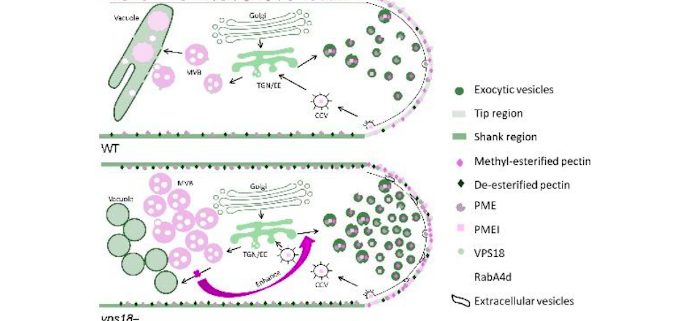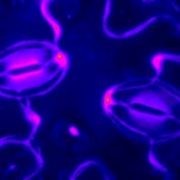A new layer of pectin regulation for pollen tube growth
Hou et al. explore the role of the HOPS/CORVET complex in plant reproduction
Saiying Hou, Sheng Zhong and Li-Jia Qu
State Key Laboratory for Protein and Plant Gene Research, Peking-Tsinghua Center for Life Sciences at College of Life Sciences, Peking University, Beijing 100871, People’s Republic of China
Background: In flowering plants, two sperm cells are transported by a pollen tube which travels a distance that is many times of its width to the female gametophyte to achieve double fertilization. Therefore, pollen tube growth is crucial for reproductive success. Components such as pectin, enzymes, lipids, and signaling molecules are secreted to the cell wall through exocytosis to sustain pollen tube growth. Furthermore, materials from the exterior or plasma membrane are internalized through endocytosis to balance exocytosis. Internalized molecules are sorted at the trans-Golgi network (TGN). Some of these molecules are transported to vacuoles through multivesicular bodies (MVBs) for degradation, whereas others are recycled back to the plasma membrane. HOPS/CORVET complexes mediate the membrane fusion between different compartments, e.g., MVBs and vacuoles. The HOPS/CORVET complex consist of six subunits, including four core subunits (VPS11, VPS16, VPS18 and VPS33) and two specific subunits.
Question: The exact mechanism by which the HOPS/CORVET complex contributes to plant reproduction, particularly in pollen tube growth, is unknown. We intended to investigate how core subunits participate in regulating reproductive processes, and selected VPS18 for functional characterization.
Findings: We found that VPS18 is essential for membrane fusion of MVBs to vacuoles in pollen tubes, since vps18 mutant pollen tubes grew more slowly and the fusion of MVBs to vacuoles was defective resulting in accumulation of MVBs. vps18 pollen tubes produced more secretory vesicles at the apex and pectin in the cell wall. Therefore, the excessive accumulation of MVBs in vps18 pollen tubes likely resulted in enhanced secretion of pectin via feedback regulation, leading to altered cell wall composition and thus, reduced pollen tube growth. We established that VPS16 and VPS33 are also involved in regulating pollen tube growth, suggesting that core subunits form a complex that regulates the process. Furthermore, VPS16 also participated in regulating pollen tube–stigma interactions, suggesting that different core subunits have different functions in reproduction.
Next steps: We revealed a mechanism by which VPS18 regulates endocytosis and exocytosis during pollen tube growth. We are currently dissecting the molecular mechanisms that underlie the different functions of the core VPS subunits during plant reproduction.
Saiying Hou, Jiao Shi, Lihong Hao, Zhijuan Wang, Yalan Liao, Hongya Gu, Juan Dong, Thomas Dresselhaus, Sheng Zhong, Li-Jia Qu. (2021). VPS18-regulated vesicle trafficking controls the secretion of pectin and its modifying enzyme during pollen tube growth in Arabidopsis. Plant Cell. https://doi.org/10.1093/plcell/koab164





